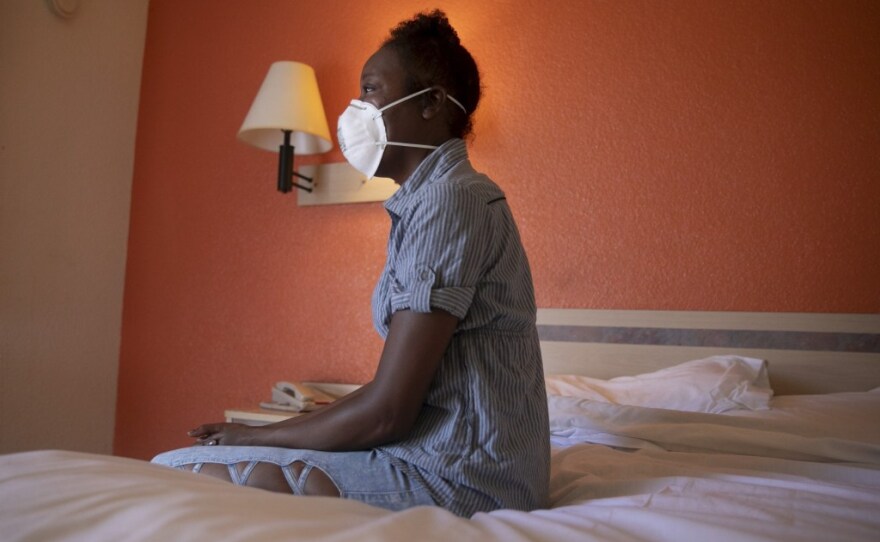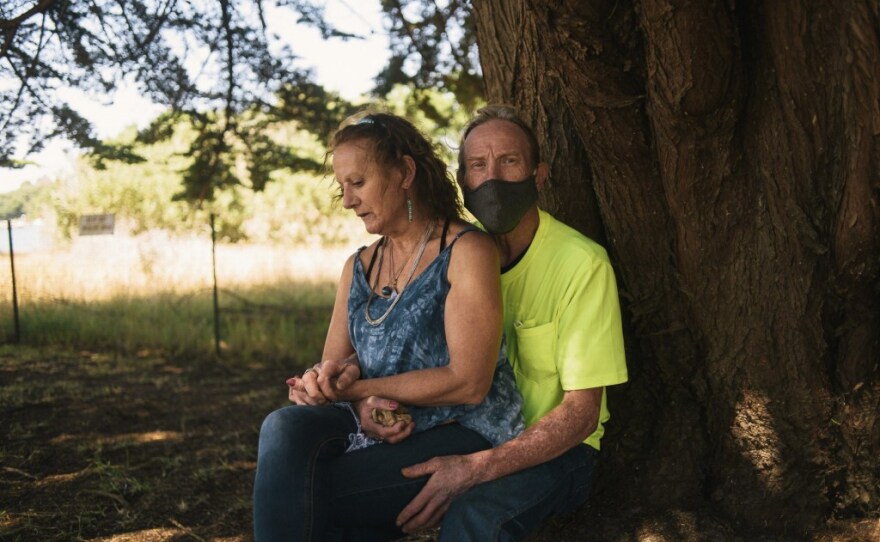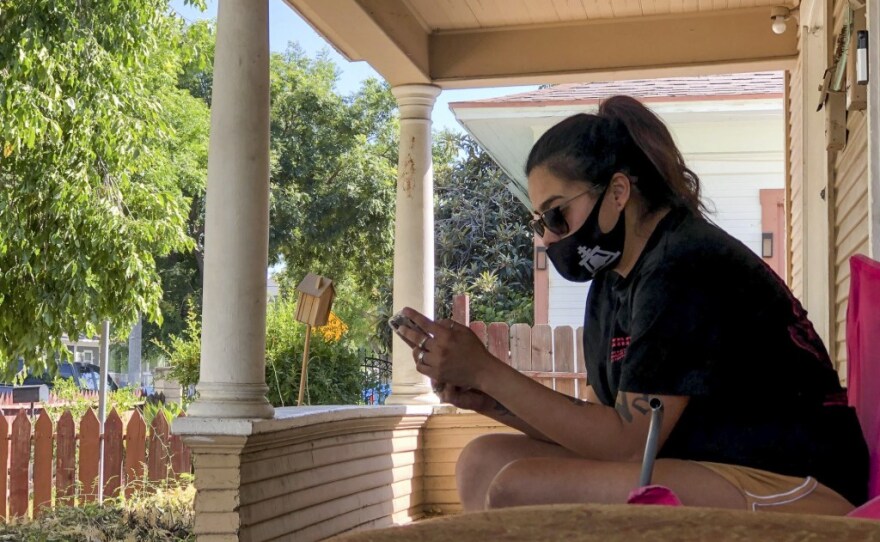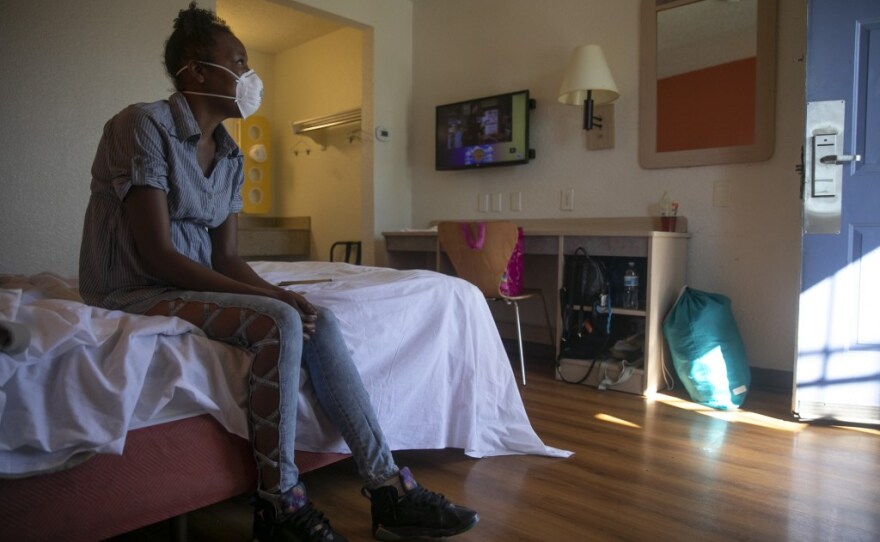Like any parent, Jamie Burson didn’t want her 11-year-old son to discover how frightened she really was about the novel coronavirus. But it’s hard to mask anxiety when you’re living and sleeping together in the same car.
After Burson was evicted from her two-bedroom apartment in Vacaville the second week of April, she heeded Gov. Gavin Newsom’s order to shelter in place by cooping up in a two-door sedan near her Walmart job. With school campuses shuttered, her son propped his school-issued laptop on top of the glovebox and attended class in the same passenger seat he slept in.
"I was scared because of how many people were dying on a daily basis.”
— Jamie Burson
It helped that he could occasionally spend a night at a relative’s or friend’s house, although Burson hesitated to ask to sleep there herself, partly out of fear of spreading the virus to friends and family.
“I was scared because of how many people were dying on a daily basis,” said Burson, who was evicted for a late February rent payment. “Made me feel like mankind was going to go extinct. I’ve never lived to see any type of disease take people out the way this one has.
More than 1,600 California households like Burson’s have been evicted since Newsom declared a statewide state of emergency March 4, according to data CalMatters obtained via public record requests from more than 40 California sheriffs’ departments. Nearly a third of those evictions took place after Newsom’s March 19 shelter-in-place order, and more than 400 since Newsom issued a self-described March 27 “eviction moratorium.”
The 1,600 evictions are likely a significant undercount of how many renters have been forced to leave their homes since the pandemic struck, as both court-sanctioned and informal evictions often do not show up on the sheriffs’ lockout lists obtained by CalMatters. Additionally, sheriffs’ departments in 14 counties did not respond to data requests; more than 14 million Californians live in those counties, including Los Angeles County with 10 million residents.
Newsom’s moratorium — which tenant groups criticized as belated and inadequate — focused on delaying eviction cases related to financial hardship from the pandemic until May 31. An April 6 emergency rule passed by the Judicial Council, the governing body for the state court system, went further, halting nearly all eviction court proceedings in California.
But neither Newsom’s executive orders nor the Judicial Council rule addressed a major subset of eviction cases: tenants such as Burson who already lost in court, often for missed rent payments in February or March, and were simply waiting on sheriffs’ deputies to lock them out. Federal eviction moratoria also did not stop these evictions.
As state lawmakers scramble to find a solution for a looming “eviction wave” when courts reopen as early as this month, tenant groups and public health experts warn that the loophole in state protections continues to endanger renters who may become homeless or move into unsafe and overcrowded housing.
Just last week, the Los Angeles County Sheriff’s Department resumed serving its backlog of nearly 1,000 scheduled eviction lockouts, even as the county remains on a state watchlist for surging coronavirus cases. When performing eviction lockouts in the past few months, San Bernardino County sheriff’s deputies encountered two separate households where tenants claimed they were quarantining because of COVID-19, according to a sheriff’s spokesperson. Those households were allowed to complete their quarantine before being evicted.
“(These evictions) could have been prevented, and it really is distressing to hear that this many people have been evicted when we have these shelter-in-place orders,” said Madeline Howard, senior staff attorney at the Western Center on Law and Poverty, which has lobbied for tighter eviction protections during the pandemic.
Unclear authority
Burson now stays in a one-bedroom motel room in Fairfield, paid for by a temporary Solano County homelessness program. She’s unsure where she’ll live once the program ends this week.

She was evicted because of a late February rent payment, lost the eviction lawsuit by default when she says she misunderstood how to respond within the legally required five-day window, and was given until early April to vacate the property. She left before she thought law enforcement was scheduled to lock her out.
While she understands that it was technically within her landlord’s right to kick her out, she wonders why the eviction wasn’t postponed.
“Why wasn’t everything set aside, period?” said Burson, who had been living in the Vacaville apartment more than a year.
ROEM Development Corporation, owner of the apartment complex from which Burson was evicted, and FPI Management, the building’s property management company, did not respond to requests for comment.
Upon being informed by CalMatters that Burson was no longer occupying the apartment, Todd Rothbard, the landlord attorney who represented ROEM in the eviction lawsuit, said his firm would consider no longer contesting a legal motion Burson had filed to remove the eviction from her record. Evictions stay on tenant records for seven years, and can make it very difficult for renters to find another place to live.
But although Rothbard sympathizes with some tenants, he pushed back on the notion that Burson should not have been evicted in the first place.
“Life can be hard,” Rothbard said. “To the extent people need help, it’s nice to see when society is able to provide help. But it is somewhat unfair to say to a landlord who is in business ‘Hey, it’s now your obligation to support this person.’ Because it’s not.”
Rothbard also said Newsom and the Judicial Council have already overstepped their constitutional powers by the eviction protections they’ve mandated. Instructing sheriffs to not perform eviction lockouts would likely be challenged in court.
Some constitutional law experts say it’s at best unclear what is and isn’t within Newsom’s power when it comes to “enforcing writs” in eviction cases — legalese for court orders to sheriffs’ departments to perform lockouts. Separation of powers between the court system and the executive branch complicates his authority.
“While a governor possesses broad authority under the Emergency Services Act to respond to the pandemic, directing county sheriffs to disobey or slow-walk lawful court orders is beyond a governor’s emergency powers,” said Stephen Duvernay, a senior research fellow at UC Berkeley’s California Constitution Center.
But pro-tenant attorneys disagree, arguing Newsom has remarkable powers during public emergencies — powers they urged the governor to deploy in early March as the first reports of hospitalizations and deaths mounted.
“There’s clearly a lot of broad powers to deal with emergencies, we just haven’t had an emergency like this in our lifetime.”
— Navneet Grewal
Navneet Grewal, litigation counsel for Disability Rights California, said that there was nothing legally restraining Newsom from ordering sheriffs to stop performing evictions for cases that pre-dated the pandemic. Newsom had included such a provision in one of his executive orders, although it only applied to cases where tenants could demonstrate financial hardship because of the virus.
“I think part of the unique thing here really is that there is no precedent of the situation that we’re in,” Grewal said. “There’s clearly a lot of broad powers to deal with emergencies; we just haven’t had an emergency like this in our lifetime.”
The Newsom administration declined multiple requests for comment.
Tenant groups also approached Attorney General Xavier Becerra to intervene.
“The reports of ongoing evictions in communities across the state and in the midst of the public health crisis are profoundly troubling,” Becerra’s press office said in an emailed statement. “Our office does not have the authority to direct Sheriffs to refuse to comply with lawful orders issued by Courts hearing eviction cases.”
But pro-tenant lawyers say Becerra is constitutionally empowered to oversee how local law enforcement executes court orders.
“I think the attorney general seems to have some priorities that are focused on dealing with the Trump administration, which are obviously very important,” Howard said. “But some of these very important issues are not getting addressed.”
Sheriff choices
On the morning of March 19, Sgt. Lydia Montoya anxiously awaited an announcement from the governor. She had heard news reports that a shelter-in-place order was coming.
The civil unit she oversees at the Kings County Sheriff’s Department had performed three evictions already that day, which they believed they were legally obligated to carry out. But Montoya and other officers in the department harbored concerns about the potential health risks — to the community and the deputies themselves — of pushing renters onto the street.
"Evicting people, them out and about looking for rentals or whatnot, or making them homeless, is not in line with his shelter-in-place order.”
— Sgt. Lydia Montoya
When Newsom issued the shelter-in-place order that afternoon, Montoya believed she had the legal justification she needed to stop evicting people. Conferring with a county attorney and the publicly elected sheriff, the department decided to stop performing eviction lockouts except in emergency cases that threatened public health and safety. Six evictions on their calendar have been indefinitely postponed. If the shelter-in-place order had come a day earlier, so would the three performed the morning of the 19th.
“The (shelter-in-place) order implies that it is a public safety issue to have people out and about,” said Montoya, who also supplied her deputies with handmade masks before her department acquired personal protective equipment. “And certainly evicting people, them out and about looking for rentals or whatnot, or making them homeless, is not in line with his shelter-in-place order.”
But not every California sheriff’s department shared Kings County’s interpretation of the governor’s executive order. Without clear guidance from the state, individual sheriffs’ departments were left to choose whether to continue with evictions already on their lockout calendars.
Many did just that. According to data obtained by CalMatters, three counties in the Inland Empire and Central Valley led the pack: San Bernardino, with 135 evictions since shelter-in-place; Riverside, with 93; and Kern County, with 68.
“It was a combination of considerations looking at both sides, obviously with the stay-at-home orders as well as the other side of the actual landlords and the people that own the property and their ability to make rent, pay bills and things like that,” said Adam Plugge, a commander at the Kern County Sheriff’s Office that oversees its eviction unit.
After Kern County sheriff’s deputies paused lockouts in late March, Plugge said his department fielded phone calls and emails from frustrated landlords and attorneys, including those referred his way from local elected officials. The lockouts resumed in April.
Plugge said that an explicit directive from the state would have avoided considerable confusion.
“It would have made decisions a lot easier to decide whether or not something could be done, and I think it would have been clearer for the public as well going forward in any shape, fashion or form,” Plugge said.
Evicting without masks
On July 1, deputies from the Humboldt County Sheriff’s Department showed up at 7886 Myrtle Avenue in Eureka to tell Ernie Bull and Mary Wildman the two had to leave.
Bull, 59, had lost a dispute with his step-brother about who should inherit the property he had been living at with his late father and step-mother. Bull said he missed a key court date because he accidentally dialed into the wrong Zoom number for a remote court hearing. Humboldt County Superior Court stopped in-person hearings because of coronavirus.

A group of Wildman’s friends were there to help them with the move. While some of their friends wore masks, Bull and Wildman didn’t — and neither did the sheriff’s deputies who came to evict them.
“If we can socially distance six feet away, then we’re not going to wear a mask,” said Lt. Mike Fridley, who oversees the department’s eviction unit.
While he couldn’t speak to the specifics of Bull and Wildman’s eviction, Fridley said that his deputies carry masks with them, and can put them on at their own discretion. Wearing masks makes it difficult for the deputies to use their radios, he said.
“I wouldn’t see any more risk than five people going to the cashier’s line in Costco.”
— Lt. Mike Fridley
Like most sheriffs’ departments, Humboldt County deputies typically perform multiple lockouts on the same day at different addresses. On the day they evicted Bull and Wildman, three other addresses were scheduled for lockouts, according to sheriff’s department documents.
Asked if he believed there was a health risk in performing multiple evictions on the same day, Fridley said “I wouldn’t see any more risk than five people going to the cashier’s line in Costco.”
Dr. Margot Kushel, director at the UCSF Center for Vulnerable Populations, said she knows of no documented case of sheriffs’ deputies spreading coronavirus through eviction lockouts. But she does fear a “nightmare scenario.”
“If you had a situation where there was a group of deputies going into different people’s households in a highly charged atmosphere, where people might be upset and might be yelling, I think you could potentially have risks for both the deputies going in and for the households being evicted,” Kushel said.
Other sheriffs’ departments interviewed for this story say they require deputies to wear protective gear while performing lockouts.
Neither Bull nor Wildman — who has kidney problems — have shown symptoms of the coronavirus since the eviction. Wildman has been staying at a friend’s place, while Bull has slept outside.
“I want to stay away from people. I’m scared,” said Bull. “I gotta admit, I’m scared.”
Landlord costs
Of course, keeping tenants in a unit for multiple months while they can’t pay rent has a cost. For Karen Clark, that cost is $10,000 — and the fear of falling behind on her mortgage.
Clark, who owns and lives in a triplex in walking distance from the University of Southern California, rents one of her units to a single father and his twin teenage daughters. She was charging $2,400 for the unit — a deal she said was well below market value for the three-bed, three-bath home near downtown Los Angeles.
“I just really liked them and I wanted to help them,” said Clark, who preferred the stability of renting to families instead of students.
Her tenant began to fall behind in his rent payments last fall when his catering business began to decline, according to Clark. Then COVID-19 hit this spring — evaporating most of what remained of her tenant’s income and, along with it, the rent.
“I’ve got to get my cash back. I went through some of my savings, now I’m robbing other bills. It’s just not gonna give forever.”
— Karen Clark, landlord
Clark said she had seriously considered evicting the tenant in March, but never filed the necessary paperwork with a court. Now those courts are closed to new eviction cases, and Clark said she has been digging into her savings to pay for utilities and other costs. She has explored forbearance options on her mortgage, but was scared of the prospect of a lump-sum payment due at the end of the forbearance period.
“I don’t know what to do,” said Clark, who has kept her job working at City National Bank during the pandemic. “I’ve got to get my cash back. I went through some of my savings, now I’m robbing other bills. It’s just not gonna give forever.”
Clark helps financially support her son and grandchild in Oregon, and rents her other unit to her daughter and son-in-law. When courts resume eviction proceedings, she plans on filing.
Stopgap measures
While sheriffs’ departments across the state continue evictions for cases that pre-date the pandemic, Newsom and state lawmakers are scrambling to head off what experts say is a looming “eviction wave” of tenants who have lost their income because of COVID-19. A UC Berkeley analysis found that as of June, nearly 1 million renter heads of households in California lost their job because of COVID-19.
Two proposals to compensate landlords and prevent more evictions are making their way through the Legislature, but both face daunting questions about how they’ll actually work.
California State Supreme Court Chief Justice Tani Cantil-Sakauye, who chairs the state Judicial Council, said the state court system could resume eviction proceedings as early as Aug. 14th. If tenants contest them, proceedings can take weeks. Because supplemental federal unemployment benefits of $600 per week expired last month, tenants groups fear swelling ranks of renters unable to afford a roof over their heads.
Unless the state intervenes or a new round of federal support is extended, 24-year old Gabriella Aldana is one of those at-risk renters and could be evicted for the second time since the virus hit California.

Just before 10 a.m. on March 26, three Riverside County Sheriff’s deputies banged on Aldana’s front door. None of the deputies wore a mask, she said, and they told her she had to leave the premises with her two children, ages 6 and 3. The family was permitted to take only what they could carry.
Aldana, then two months pregnant, and her two children piled what they could into her 2013 Honda Accord and drove off into a pandemic at a time when public health officials didn’t know much about the virus.
She left her job at Walmart, she said, over fears of infecting her daughters or complicating her own pregnancy. The night of her eviction, she stayed in a hotel, then moved in for a few days with her parents. She eventually found a studio apartment for the April for $1170. After that, they moved into a two-bedroom duplex in downtown Riverside. The new place is beyond their current means, but also the only place that would accept Aldana, who said she has bad credit.
She has survived on unemployment benefits and, especially, the $600 weekly federal unemployment boost.
If the federal unemployment boost isn’t renewed by late August, Aldana and her children will likely once more be evicted. Even if she gets one of the jobs she’s interviewed for recently, her monthly take-home pay after taxes would be about $1,600. Her rent is $1,595.
“I have some savings to cover some of (rent) next month, I might look for a roommate if the job doesn’t come through and the (federal unemployment benefits) goes away,” Aldana said. “I have to start looking for all of that because now it’s just me.”
About the Data
The data used in the graphics in this article are based on records and data from 44 county sheriff departments (Alameda, Alpine, Amador, Butte, Calaveras, Colusa, Contra Costa, El Dorado, Glenn, Humboldt, Imperial, Kern, Kings, Lake, Lassen, Madera, Marin, Merced, Mono, Monterey, Nevada, Orange, Placer, Plumas, Riverside, San Bernardino, San Diego, San Joaquin, San Luis Obispo, San Mateo, Santa Barbara, Santa Clara, Santa Cruz, Shasta, Sierra, Siskiyou, Solano, Sonoma, Stanislaus, Sutter, Trinity, Tuolumne, Ventura, Yolo). Public records act requests to many departments yielded names and former addresses of tenants, as well as the date of eviction.
CalMatters did not receive data from 14 sheriff departments (Del Norte, Fresno, Inyo, Los Angeles, Mariposa, Mendocino, Modoc, Napa, Sacramento, San Benito, San Francisco, Tehama, Tulare, Yuba).
Evictions may include a small number of commercial evictions and cases involving threats to public health and safety. Where possible, commercial evictions were excluded by comparing occupant names and addresses to county and city property records and business license listings, real estate listings and business locators. CalMatters accepted statements from counties in which sheriffs said they did not perform any evictions since March 4.
The range of data included varies based on when data was requested. Sheriff departments may have pursued more evictions since CalMatters requested data.
Data from San Bernardino County excludes a two-week period during June 11-28, 2020.
Population data for each county is based on the 2018 American Community Survey.






